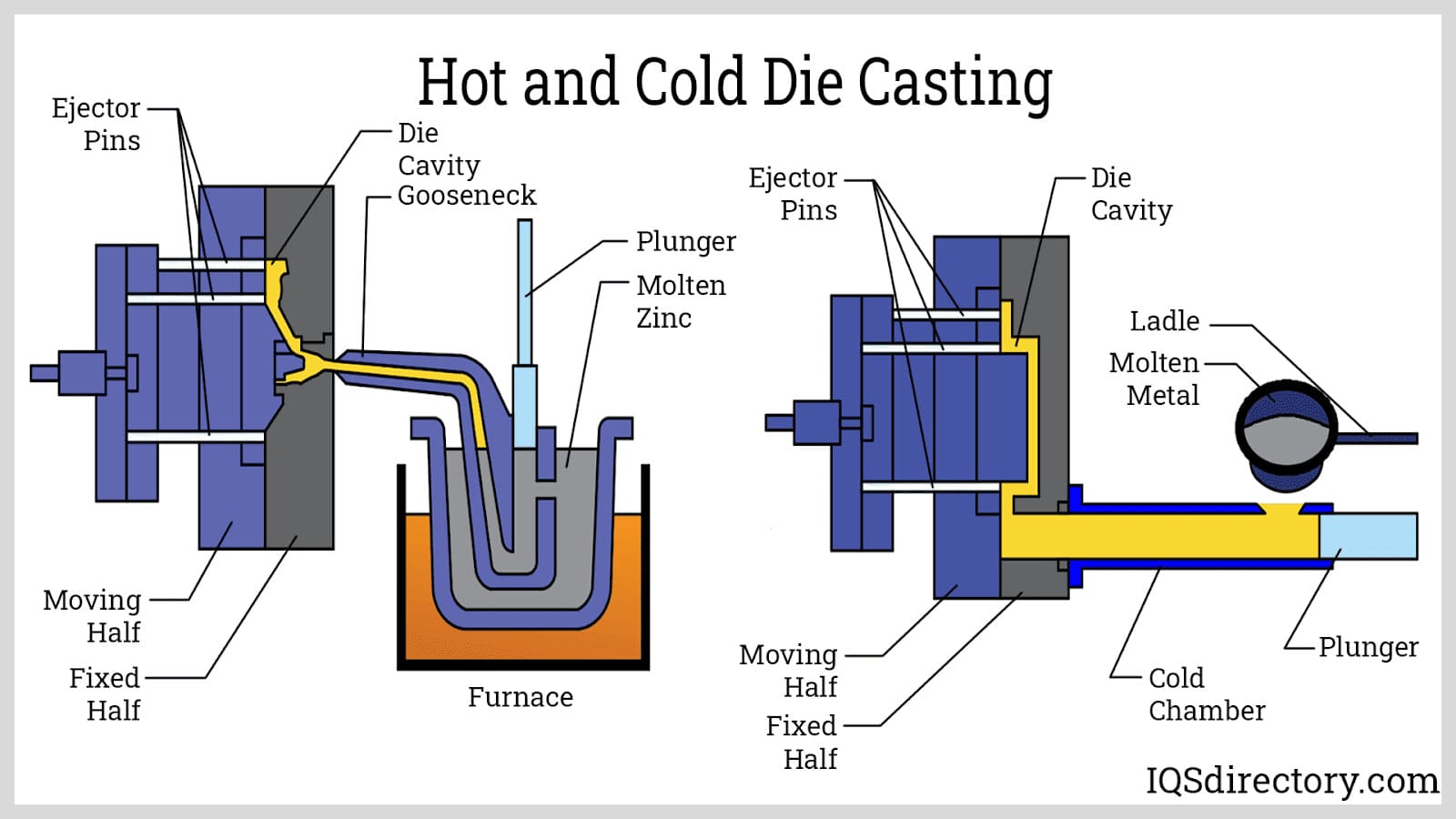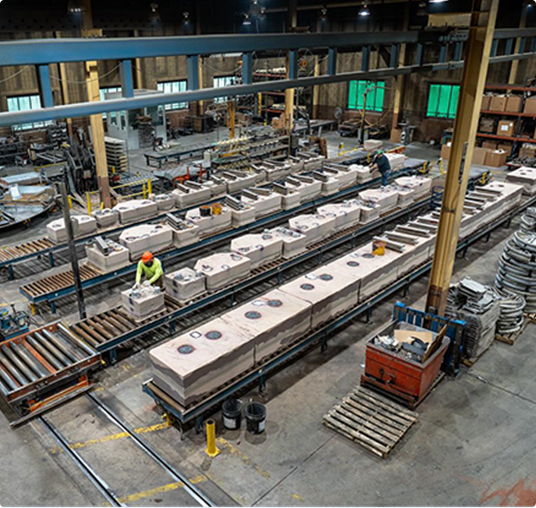Innovations at Wisconsin Aluminum Foundry that improve efficiency
Wiki Article
Exploring the Diverse Applications and Advantages of Aluminum Foundry in Modern Manufacturing
Aluminum factories are crucial in today's production landscape. They create components that serve various sectors, consisting of auto and aerospace. The lightweight nature of Aluminum combined with its resilience makes it a preferred choice. Additionally, cutting-edge spreading methods improve manufacturing performance. The ramifications of these improvements on sustainability and future patterns require further exploration. What opportunities and obstacles exist ahead for Aluminum shops in this progressing market?The Function of Aluminum Foundries in Modern Manufacturing
Aluminum foundries play a necessary function in modern production, contributing significantly to different industries such as vehicle, aerospace, and construction. These centers specialize in the melting and spreading of aluminum, a light-weight, resilient material understood for its excellent deterioration resistance and thermal conductivity. The factories utilize innovative techniques, consisting of sand casting, pass away casting, and financial investment casting, to generate top quality parts tailored to certain applications.Key Applications of Aluminum Elements Across Industries
Throughout various markets, Aluminum parts are essential to boosting efficiency and performance. In the vehicle sector, Aluminum is commonly made use of for engine blocks, transmission instances, and structural elements, adding to lighter cars that enhance gas effectiveness. The aerospace sector relies upon Aluminum for airplane frames, wings, and parts, making use of its high strength-to-weight ratio to enhance trip performance.In electronic devices, Aluminum is used in warm sinks and coverings, offering efficient thermal management while preserving lightweight characteristics (Wisconsin Aluminum Foundry). The building and construction industry benefits from Aluminum in window frames, roof covering, and cladding, where longevity and looks are vital
In addition, packaging applications use Aluminum for foils and canisters, offering an efficient obstacle against wetness and light. In each of these markets, Aluminum parts not just sustain useful needs however also promote sustainability through recyclability, making them a preferred choice in modern-day production techniques.

Benefits of Aluminum Compared to Various Other Materials
The flexibility of Aluminum makes it a superior selection over lots of other products in producing applications. One of its primary advantages is its light-weight nature, which adds to decreased power usage and improved performance in transportation and building and construction markets. Furthermore, Aluminum shows excellent deterioration resistance, improving the longevity of items without the need for substantial maintenance.Moreover, aluminum's pliability permits intricate styles and forms, catering to varied industry requirements, from automotive to aerospace. Its thermal and electrical conductivity likewise exceeds that of several alternatives, making it excellent for applications requiring warm dissipation or electric transmission.
Aluminum is highly recyclable, advertising sustainability in making procedures. Compared to steel, it provides a desirable strength-to-weight ratio, enabling for durable yet light-weight frameworks. Jointly, these features position Aluminum as a preferred material, allowing suppliers to attain both efficiency and sustainability in their products.
Innovative Casting Strategies in Aluminum Foundries
In the domain name of Aluminum manufacturing, innovative casting strategies are revolutionizing the production process and enhancing the material's applications. Among these techniques, die casting stands out for its capacity to generate complicated shapes with high precision and very little waste. This method enables rapid mass production, making it optimal for markets such as auto and electronic devices. Financial investment spreading has gained appeal due to its capacity to develop complex styles with outstanding surface area coating, fitting both big and tiny elements.Another notable strategy is sand casting, which offers versatility and cost-effectiveness for generating majorities. Current developments in 3D printing innovations are also being incorporated into Aluminum spreading, allowing rapid prototyping and modification. These advancements not only enhance performance however additionally broaden the possibilities for Aluminum applications throughout various fields, eventually driving the advancement of contemporary production techniques.
Sustainability Campaigns in Aluminum Production
Sustainability efforts in Aluminum production emphasis on enhancing recycling procedures, which significantly lower energy usage and emissions. Carrying out power effectiveness techniques even more adds to a reduced carbon footprint, making Aluminum a much more eco-friendly product. These efforts show the sector's commitment to sustainable production and source conservation.Recycling Aluminum Conveniences
While Aluminum manufacturing is resource-intensive, reusing Aluminum presents considerable advantages that straighten with sustainability initiatives in manufacturing. Reusing Aluminum requires only 5% of the power needed for primary manufacturing, considerably lowering greenhouse gas exhausts. This energy performance not just preserves natural deposits but likewise lessens the environmental impact connected with mining and refining resources. In addition, reusing Aluminum sustains a circular economy by reintroducing products back right into the supply chain, therefore reducing waste and promoting resource conservation. The process likewise produces economic benefits with task creation in recycling facilities and decreases reliance on foreign Aluminum sources. In general, reusing Aluminum is a vital element of lasting methods that add to a much more ecologically responsible manufacturing landscape.Energy Performance Practices
The Aluminum production market Aluminum Castings is progressively taking on power effectiveness methods to improve sustainability alongside recycling efforts. These initiatives focus on optimizing power usage throughout the production process. Manufacturers are implementing sophisticated innovations such as high-efficiency heaters and smart grid systems, which enable far better power administration and reduced waste. Additionally, the combination of renewable resource resources, like solar and wind power, is coming to be much more common, additionally reducing dependence on fossil fuels. Continuous tracking and analysis of power use help with the recognition of ineffectiveness and opportunities for enhancement. Furthermore, labor force training on energy-saving techniques guarantees that staff members proactively contribute to power preservation initiatives, developing a society of sustainability within visit this website the organization. These techniques jointly sustain an even more sustainable Aluminum manufacturing landscape.Lowered Carbon Footprint
To attain a reduced carbon impact, the Aluminum production market is increasingly embracing ingenious sustainability efforts. Business are buying innovative technologies that decrease energy consumption and discharges throughout the production procedure. The assimilation of sustainable power sources, such as solar and wind power, plays a critical function in decreasing dependence on nonrenewable fuel sources. Furthermore, the recycling of Aluminum scrap considerably decreases the carbon footprint, as recycled Aluminum needs just a portion of the energy required for primary production. Collaborative efforts amongst manufacturers, governments, and ecological companies further drive development in sustainability. By taking on these measures, the Aluminum market not only addresses ecological problems but also improves its one-upmanship in a market increasingly focused on eco-friendly methods.Future Patterns in Aluminum Foundry Innovation
Technology goes to the center of Aluminum Foundry technology, driving significant improvements and reshaping market methods. Emerging patterns include the combination of synthetic intelligence and artificial intelligence, enhancing process optimization and quality control. These technologies promote anticipating upkeep, minimizing downtime and enhancing operational efficiency. Additionally, making use of 3D printing and additive manufacturing is gaining grip, permitting complicated geometries and decreased material waste.Sustainability remains a critical emphasis, with innovations in reusing methods enhancing the round economic situation of light weight aluminum. Business are increasingly taking on energy-efficient techniques, such as low-pressure die casting, which minimize power intake and discharges. Furthermore, electronic doubles are ending up being commonplace, enabling real-time surveillance and simulation of Foundry processes.

Often Asked Questions
What Precaution Are in Location at Aluminum Foundries?
Aluminum shops implement numerous safety procedures, consisting of protective gear, correct air flow, fire prevention systems, regular security training, and emergency situation protocols to alleviate dangers linked with high temperatures, molten metal handling, and prospective direct exposure to hazardous materials.Your Domain Name
How Do Aluminum Foundries Make Sure Quality Assurance Throughout Manufacturing?
Aluminum shops apply rigorous top quality control procedures such as normal examinations, product testing, and adherence to industry requirements. These protocols ensure uniformity in items while decreasing issues, eventually improving the dependability and efficiency of Aluminum components.What Are the Usual Obstacles Dealt With by Aluminum Foundries?
Aluminum factories typically face obstacles such as preserving regular high quality, managing production costs, guiding regulative compliance, addressing tools maintenance issues, and adjusting to changing market demands, every one of which can affect operational efficiency and earnings. - Aluminum CastingsExactly how Does the Aluminum Recycling Process Operate In Foundries?
The Aluminum recycling process in shops entails collecting scrap light weight aluminum, thawing it in furnaces, getting rid of contaminations, and casting the molten steel into wanted forms, thereby reintroducing it into the manufacturing cycle properly and sustainably.What Are the Task Opportunities Available in Aluminum Foundries?
Job opportunities in Aluminum factories consist of duties such as Foundry operators, quality control examiners, maintenance service technicians, designers, and manufacturing supervisors. These settings need different skill degrees, offering prospective for profession development within the manufacturing market.Sustainability initiatives in Aluminum production focus on enhancing recycling procedures, which substantially minimize energy usage and exhausts. While Aluminum manufacturing is resource-intensive, recycling Aluminum presents considerable advantages that line up with sustainability campaigns in manufacturing. Recycling Aluminum needs just 5% of the power needed for primary manufacturing, significantly lowering greenhouse gas exhausts. The Aluminum production field is progressively embracing power performance techniques to boost sustainability along with recycling initiatives. In addition, the recycling of Aluminum scrap considerably lowers the carbon footprint, as recycled Aluminum requires just a portion of the power required for primary manufacturing.
Report this wiki page